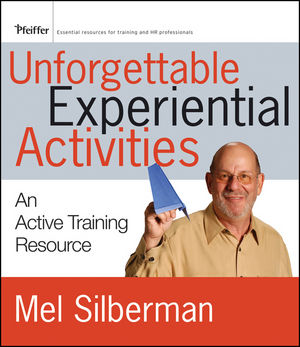Unforgettable Experiential Activities: An Active Training ResourceISBN: 978-0-470-53714-5
Paperback
320 pages
April 2010, Pfeiffer
 This is a Print-on-Demand title. It will be printed specifically to fill your order. Please allow an additional 10-15 days delivery time. The book is not returnable.
|
||||||
Preface ix
Acknowledgments xiii
Foreword xv
Introduction 1
Chapter One: Getting Acquainted 11
1. Alphabetical Circle: A Fun Way to Learn Names and a Lot More 12
2. Group Résumé: Who We Are Collectively 14
3. Things We Have in Common: Getting to Know You 16
4. Predictions: Making Guesses About Co-Participants 18
5. Introductory Go-Arounds: Brief Self-Disclosures 20
6. What’s in a Name? My Story 22
Chapter Two: Communication 25
7. Communication Tokens: An Awareness Exercise 26
8. Direct Communication: You Write the Scripts 28
9. Explaining Something Complicated: Avoiding Information Dumps 30
10. Obtaining Participation: Using Different Formats 34
Chapter Three: Assertive Behavior 41
11. Concerns About Confronting Employees: Overcoming the Anxiety 42
12. Assertive Starters: Ways to Begin an Assertive Message 46
13. Non-Verbal Persuasion: Assessing Its Impact 50
14. Refusing Unwanted Requests: Practicing Saying No 52
15. Stating Complaints and Requesting Change: Skill Practice 56
Chapter Four: Influencing Others 59
16. Alligator River: Looking at People with Different Glasses 60
17. Question First: The Best Way to Overcome Resistance 65
18. Influencing Others: Four Role-Play Scenarios 68
19. Getting Your Foot in the Door: Avoiding Rejection 72
Chapter Five: Conflict and Negotiation 75
20. Views of Conflict: A Word Association Game 76
21. What You Bring to Conflict Situations: Experiencing Different Styles 79
22. The Ten-Thousand-Dollar Challenge: Working Through a Conflict 85
23. Role Reversal: Arguing the Flip Side 89
24. Rating Methods to Deal with Conflict: Yours and Theirs 92
25. Breaking a Stalemate: Steps to Move Forward 95
Chapter Six: Creativity and Problem Solving 99
26. Getting Ready for Brainstorming: Creative Warm-Ups 100
27. Part Changing: Demonstrating a Technique to Increase Creativity 105
28. Brainwriting: An Alternative to Generating Ideas Verbally 108
29. Inspired Cut-Outs: Freeing the Mind 110
30. Wearing Someone Else’s Shoes: Taking a Different Perspective 113
31. Making Decisions After Brainstorming: Narrowing the Options 116
Chapter Seven: Diversity 119
32. Being in the Minority: Simulating an Everyday Reality 120
33. I’ve Been Curious: Questions I Have Been Afraid to Ask 124
34. Setting the Record Straight: Things About Me and Others Like Me 127
35. Unlocking Memories: Self-Disclosures in a Diverse Group 130
Chapter Eight: Facilitating Teams 133
36. Multi-Voting: A Constructive Way to Make Decisions 134
37. Rotating Facilitators: Practicing Effective Facilitation 137
38. Card Exchange: A Unique Way to Stimulate Discussion 142
39. The Problem with Majority Voting: A Double Whammy 145
40. Changing the Rules: Altering Group Process 148
41. Removing Egos: A Tool for Team Facilitators 151
Chapter Nine: Exchanging Feedback 155
42. Animal Metaphors: An Exercise in Obtaining Honest Feedback 156
43. Giving Effective Feedback: Wheaties Over Donuts 163
44. Judging the Impact of Words: Applications to Giving Feedback 168
45. When Asking for or Giving Feedback Is Challenging: Your Advice 173
Chapter Ten: Leadership 177
46. The Window Shade: Depicting Different Approaches to Decision Making 178
47. Mirroring: Experiencing the Joys and Tribulations of Being a Leader 181
48. Going Outside Comfort Zones: Brief Exercises in Change 185
49. Changes You Would Make: Dreaming Beyond the Status Quo 190
Chapter Eleven: Teaching and Coaching Employees 195
50. Making Butterflies: It’s Not What You Say That Counts 196
51. Brain-Friendly Teaching: Using Four Key Principles 202
52. Building Skills Through Role Plays: You Have Options 208
53. The Components of Effective Coaching: Observing the Process 218
54. Show But Not Tell: Upping the Stakes 218
Chapter Twelve: Understanding Others 221
55. Avoiding Labels: Interpreting Behavior Objectively 222
56. Be Curious, Not Furious: Five Ways to Understand Others 227
57. Comparing Yourself to Others: Looking for Differences and Similarities 231
58. The Three C’s: What Makes People Difficult 234
Chapter Thirteen: Sales and Customer Service 239
59. A Convincing Sales Presentation: Warm-up Practice 240
60. Dissatisfied Customers: How to Win Them Over 243
61. To Consult or Not Consult: Assessing Your Selling Style 248
62. Your Company’s Sales Philosophy: How Do You Treat Customers? 251
Chapter Fourteen: Team Building 255
63. The Stages of Team Development: A Card Sorting Activity 256
64. Television Commercial: An Unusual Team-Building Activity 262
65. Creative House Building: An Exercise in Teamwork 264
66. Fishbowl Meeting: Observing Group Process 266
67. Making Paper Cups: Simulating a Learning Organization 269
68. Are You a Team Player? Things Team Players Do 274
69. Paper Airplanes: The Power of Collaboration 278
Chapter Fifteen: Train the Trainer 281
70. Active Vacations: Topics Versus Objectives 282
71. Design Challenges: Planning How to Achieve Training Objectives 286
72. Energizers: Ways to Wake Up or Relax a Training Group 289
73. Has This Ever Happened to You? Making Team Learning Work 292
74. Training Styles: Three Continua 296
75. You Have Many Options: Increasing Your Training Repertoire 298
About the Author 301



